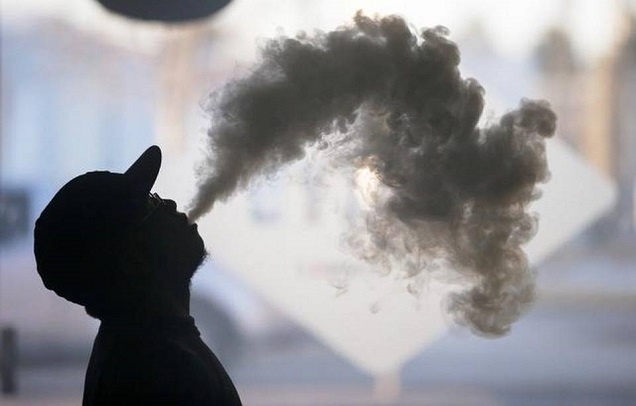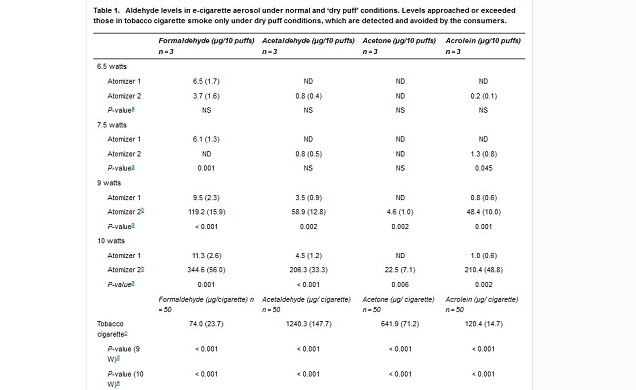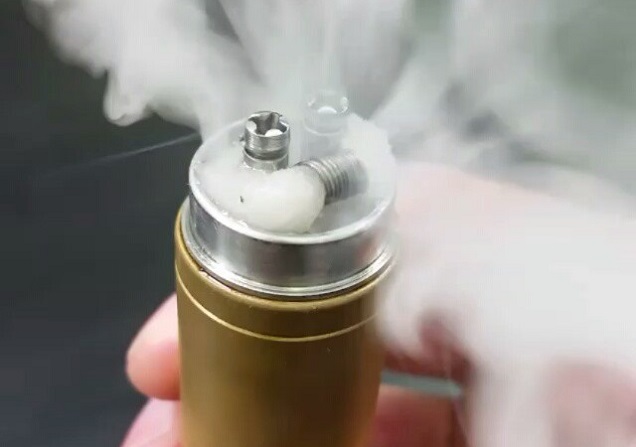
A new study from Dr. Konstantinos Farsalinos has offered confirmation that previous formaldehyde scares were due to “dry puffs,” and that with more capable atomizers (even at high powers), the levels generated are vastly lower than from cigarettes. The formaldehyde panic has been repeated a few times, recently in a New England Journal of Medicine article, but also once in a Japanese study and another time before that. The purported message was that high power e-cigarettes (in comparison to increasingly Big-Tobacco-backed cigalikes) generate shocking levels of formaldehyde, acetaldehyde and similar chemicals, in some cases higher than those from cigarettes.
The problem was that in all of the scary cases, high levels of power were supplied to inferior atomizers, and anybody with the smallest amount of knowledge about vaping readily identified it as probably leading to dry puffs. This was fairly convincing (at least for us vapers) anyway, but now we have objective evidence that this is indeed the case.
The Results at a Glance
- Researchers used Kayfun Lite Plus atomizers with two wick setups (single and dual wicks) at four power settings (6.5, 7.5, 9 and 10 W), recruiting seven vapers to detect dry puff conditions before testing for formaldehyde and other aldehydes using a smoking machine.
- All vapers identified dry puffs at 9 and 10 W on the single-wick setup.
- Formaldehyde, acetaldehyde and acrolein levels in vapor were extremely low in usable conditions, but increased by 30 to 250 times in those identified as dry puffs by vapers, sometimes exceeding the levels emitted by a cigarette.
- This strongly suggests that previous studies only found high levels of aldehydes in dry puff conditions, and that vapers in the real-world are only exposed to minimal levels of such chemicals.
The Study – Testing the Chemistry of Dry Puffs vs. Normal Vaping
The authors of the study (free full text available for a month) did what we’ve urged other researchers to do every time this story rolls around: use actual vapers to ensure that you’re testing realistic usage conditions. They used two Kayfun Lite Pluses, setting up one with a double-wick (to improve wicking ability and reduce the chance of dry puffs) and one with a single wick, both made from silica. They used a 50/50 PG/VG liquid, chosen because this type of e-liquid generated the most aldehydes in previous research. Seven vapers were recruited (so that differences in their ability to detect dry puffs were accounted for), and asked to vape at four power levels (6.5, 7.5, 9 and 10 W) from a Hana Modz DNA 40 mod, unaware of which atomizer setup they were using.
They took four puffs, with each being four seconds long and with an interval of 30 seconds between puffs. They choose four puffs because the temperature on the first puff is lower (since the coil is heating from room temperature) and gets progressively higher with each puff, making dry puffs more likely. The authors then used a smoking machine, set to the same puff length and interval between puffs, which took 60 puffs (repeated three times per power setting per atomizer), and these were tested for levels of formaldehyde, acetaldehyde, acrolein and acetone. They also tested blank samples from the air and subtracted background levels from those measured.
What They Found – Vapers Can Tell If They’re Vaping Formaldehyde
The short version of the findings is that if you’re vaping high levels of aldehydes, you’ll know about it. Every vaper identified dry puffs on the single-wicked atomizer at 9 and 10 W, with none reporting dry puffs at any power level on the dual-wicked atomizer, nor on the single-wicked one at lower powers.

The subsequent testing of the vapor (technically aerosol) shows that dry puff conditions were associated with much higher levels of formaldehyde, acetaldehyde and acrolein, with acetone only being detected in dry puff conditions. On both atomizers (including the double-wicked one that didn’t lead to dry puffs), levels of formaldehyde, acetaldehyde and acrolein increased as the power rose: for example, formaldehyde went from 6.5 micrograms (millionths of a gram) per 10 puffs at 6 watts to 11.3 micrograms at 10 watts in the dual-wick setup, and acetaldehyde went from not being detected at 6.5 W to 4.5 micrograms per 10 puffs at 10 watts. A tobacco cigarette, in comparison, releases 74 micrograms of formaldehyde (over 6.5 times more than the highest detected in e-cig vapor in usable conditions) and 1,240 micrograms of acetaldehyde (over 275 times more than the highest amount in e-cig vapor in usable conditions), with much higher levels of acrolein and plenty of acetone too.
For dry puff conditions, the picture is very different, with the single-wicked atomizer having drastically raised levels of formaldehyde, acetaldehyde and acrolein – an increase of between 30 and 250 times the non-dry puff levels. Peak formaldehyde levels (at 10 W) were 344.6 micrograms per 10 puffs (over 4.6 times higher than from a cigarette) and for acrolein it was 210.4 micrograms (about 75 percent higher than from a cigarette), with acetaldehyde and acetone levels still being much lower than from a cigarette even in dry puff conditions.
Crucially, the higher levels arose precisely when vapers detected dry puffs, with formaldehyde going from being undetectable at 7.5 W to 119.2 micrograms per 10 puffs at 9 W and acetaldehyde going from 0.8 micrograms to 58.9 micrograms per 10 puffs as the power increased from 7.5 to 9 W. This is the key point here: vapers can detect when these levels increase, so although only one type of atomizer was tested in this study (and more will be covered in future) we can be fairly confident that we’ll be able to tell – by the mercilessly disgusting taste – when we’re being exposed to higher levels of aldehydes. Even if you had no idea about the past formaldehyde scares, no vaper in possession of tastebuds would choose to continue vaping like this.
So, was this to blame for the findings in the other studies? Almost definitely. The first study along these lines used a top-coil clearomizer at about 9.5 W, finding 27 micrograms of formaldehyde per 15 puffs, and the most recent study used a top-coil clearomizer at 12 W, finding formaldehyde hemiacetals (a combination of formaldehyde and PG or VG) at 380 micrograms per 10 puffs. Had they even considered whether this was realistic usage, they would have undoubtedly found that any vaper would have answered (correctly) that it wasn’t.
Dry Puffs Explained
So what’s happening at these high power settings? When you hit your “fire” button, you begin to vaporize liquid soaked into the wick, meaning that substantial amounts of the energy you’re supplying (since power is simply energy supplied per second) is transferred to the liquid, keeping the temperature relatively low and being associated with the vastly lower levels of aldehyde production seen through most of this study. The important factor is whether the wick re-supplies liquid to the coil quick enough for your chosen power setting. If more liquid reaches the wick, then it is also vaporized by the energy you supply and the temperature of the setup remains comparatively low.


When liquid isn’t re-supplied to the coil quick enough, the energy you’re supplying has nowhere else to go, so it goes into raising the temperature. If you’re a rebuilder, this is effectively why a dry-fire leads to a glowing coil but one with a wick and liquid fully setup doesn’t (as shown above – although this is a bit of a simplification): the newly supplied liquid continues to absorb the energy and keeps the temperature down. So with a poor liquid re-supply the temperature rises notably. Then, any liquid near the coil is heated to excessive levels, and chemistry stuff happens (an incomplete combustion reaction – nicely explained here), leading the PG (and possibly the VG) to degrade into formaldehyde and other aldehydes.
The easiest way to avoid dry puffs is to trust your tastebuds. As this study shows, you’ll be able to tell, and you’ve probably experienced it (accidentally) already. Otherwise, you can simply ensure that you only use atomizers with efficient wicking (rebuildables, for example) at higher power settings. As the authors note, though, there are many different devices, and even the same device using different wicking setups (as in this study) can vary in when it produces dry puffs. More research is needed to reliably predict when this will happen, so the best advice is to do what you’ve been doing anyway: don’t vape anything that’s eye-wateringly unpleasant.
Conclusion – Where’s the Media Attention?
Isn’t it just shocking that the other formaldehyde studies generated tons of media attention, but this one only managed (based on a quick Googling) to scrape one article? It’s almost as if the media preferentially reports on studies suggesting risk from e-cigarettes and completely ignores ones that support the scientifically-backed viewpoint that they are vastly lower in risk than cigarettes, and probably only carry pretty small risks even in an absolute sense. This is more good news for vapers, but sadly, most of the public will be in the dark about the science on vaping until the next scare-story comes out.

